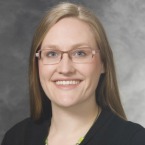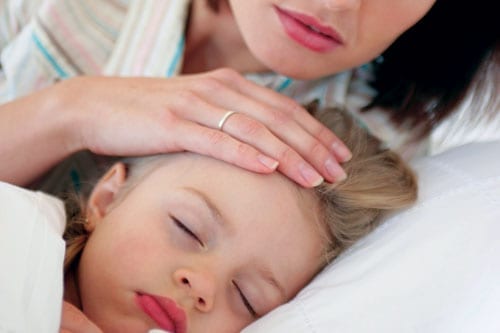By: Andrea Jones, MD, FAAP
Almost all children get RSV at least once before they are 2 years old. For most healthy children, RSV is like a cold. But, some children get very sick with RSV.
What is RSV?
RSV (or respiratory syncytial virus) is one of the many viruses that cause respiratory illness―illnesses of the nose, throat, and lungs. This virus occurs in the late fall through early spring months.
Typically, RSV causes a cold, which may be followed by bronchiolitis or pneumonia. Symptoms generally last an average of 5-7 days.
Cold: Upper Respiratory Tract Infection
|
Bronchiolitis: Lower Respiratory Tract Infection |
|---|---|
Symptoms may include:
|
Symptoms may include cold symptoms, plus:
|
How hard is your baby breathing? Know what to look for. |
|---|
|
Chest wall retractions occur when a baby must use muscles between the ribs or in the neck to breathe. It is a sign that baby is having to work harder than normal to breathe. Watch your child’s rib cage as he or she inhales. If you see it “caving in” and forming and upside-down “V” shape under the neck, then he or she is working too hard. |
Is your baby or young child at a greater risk?
Those infants with a higher risk for severe RSV infection include:
- Young chronological age (≤12 weeks) at the start of RSV season
- Premature or low birth weight infants (especially those born before 29 weeks gestation)
- Chronic lung disease of prematurity
- Babies with certain types of heart defects
- Those with weak immune systems due to illness or treatments
- Additional risk factors for severe RSV infections include low birth weight, having siblings, maternal smoking during pregnancy, exposure to secondhand smoke in the home, history of atopy (allergies/eczema), not breastfeeding, and being around children in a child care setting or living in crowded living conditions.
When should you call the doctor?
RSV symptoms are typically at their worst on days 3 through 5 of illness.Fortunately, almost all children recover from an RSV infection on their own.
Call your pediatrician right away if your child has any:
- Symptoms of bronchiolitis (listed above)
- Symptoms of dehydration (fewer than 1 wet diaper every 8 hours)
- Pauses or difficulty breathing
- Gray or blue color to tongue, lips, or skin
- Significantly decreased activity and alertness
Some children with RSV may be at increased risk of developing a bacterial infection, such as an ear infection. Call your doctor if your child has:
- Symptoms that worsen or do not start to improve after 7 days
- A fever (with a rectal temperature of 100.4°F or higher) and he or she is younger than 3 months of age (12 weeks).
- A fever that rises above 104°F repeatedly for a child of any age.
- Poor sleep or fussiness, chest pain, ear tugging, or ear drainage
How do doctors diagnose RSV?
Pediatricians diagnose children with a cold or bronchiolitis by asking about their symptoms and by doing a physical exam. Your pediatrician may do a nasal swab test to determine if your child has RSV or another virus. A chest x-ray and/or oxygen saturation test may also be done to check for lung congestion. Because most children recover without difficulty and because there is no treatment for RSV, these tests usually are not necessary.
Is RSV contagious?
Yes. RSV spreads just like a common-cold virus―from one person to another. It enters the body through the nose or eyes or, usually from:
- Direct person-to-person contact with saliva, mucus, or nasal discharge.
- Unclean hands (RSV can survive 30 minutes or more on unwashed hands).
- Unclean objects or surfaces (RSV can survive up to 6 hours on surfaces, toys, keyboards, door knobs, etc).
Symptoms can appear 2 to 8 days after contact with RSV. According to the Centers for Disease Control and Prevention (CDC), people infected with RSV are usually contagious for 3 to 8 days. However, some infants and people with weakened immune systems can be contagious for as long as four weeks―even if they are not showing symptoms.
Keep in mind, children and adults can get RSV multiple times–even during a single season. Often, however, repeat infections are less severe than the first one.
What can you do to help your child feel better?
There is no cure for RSV and medications, like steroids and antibiotics, do not help with RSV.
To help your child feel more comfortable, begin by doing what you would for any bad cold:
- Nasal saline with gentle suctioning to allow easier breathing and feeding.
- Cool-mist humidifier to help break up mucus and allow easier breathing.
- Fluids and frequent feedings. Make sure your child is staying hydrated. Infants with a common cold may feed more slowly or not feel like eating, because they are having trouble breathing. Try to section baby’s nose before attempting to breast or bottle-feed. Supplementation with water or formula is unnecessary for breastfed babies. If difficult for the baby to feed at the breast, expressing breastmilk into a cup or bottle may be an option.
- Acetaminophen or ibuprofen (if older than 6 months) to help with low-grade fevers. Always avoid aspirin and cough and cold medications.
Only 3% (3 out of 100 children) with RSV will require a hospital stay. Those children may need oxygen to help with breathing or an (intravenous) IV line for fluids. Most of these children can go home after 2 or 3 days. Rarely, a child may need care in a pediatric intensive care unit (PICU).
How can you protect your children from RSV?
Wash your hands! Just as you would to prevent germs at any time, use soap and water and scrub for at least 20 seconds. Remind children to practice good hand hygiene all through the year.
Other things that can help:
- Vaccinate. Keep your children up to date on their immunizations and get the whole family annual flu shots. Getting vaccinated with Tdap―to protect against whopping cough is especially important for adults who are around infant—new parents, grandparents, babysitters, nannies, etc.
- Limit your baby’s exposure to crowds, other children, and anyone with colds. Keep them home from school or child care when they are sick and teach them to cover their coughs and sneezes.
- Go germ-free. Disinfect objects and surfaces in your home regularly and avoid exposing your child to smoke from tobacco or other substances.
- Feed your baby breastmilk. It has unique antibodies to prevent and fight infections.
Injections for high-risk infants:
A medication called palivizumab (Synagis®) may reduce the risk of severe RSV infection in some high-risk infants. Your pediatrician will let you know if your baby is a candidate.
Hope on the horizon:
Medicine is always advancing! Scientists are currently studying vaccines to prevent and medications to treat RSV. We may have more options in the future. In the meantime, rest assured that most children recover well from RSV and grow to be healthy adults.
Additional Information:
- Treating Bronchiolitis in Infants
- Bronchiolitis
- When to Keep Your Child Home from Child Care
- RSV in Infants and Young Children (CDC.gov)
About Dr. Jones:
 Andrea N Jones, MD, FAAP, is a board-certified general pediatrician. She is an Assistant Professor in the Department of Pediatrics at the University of Wisconsin School of Medicine and Public Health. Dr. Jones is a member of the Wisconsin Chapter of the American Academy of Pediatrics.
Andrea N Jones, MD, FAAP, is a board-certified general pediatrician. She is an Assistant Professor in the Department of Pediatrics at the University of Wisconsin School of Medicine and Public Health. Dr. Jones is a member of the Wisconsin Chapter of the American Academy of Pediatrics.
- Last Updated
- 12/6/2018
- Source
- Section on Infectious Diseases (Copyright © 2018 American Academy of Pediatrics)

